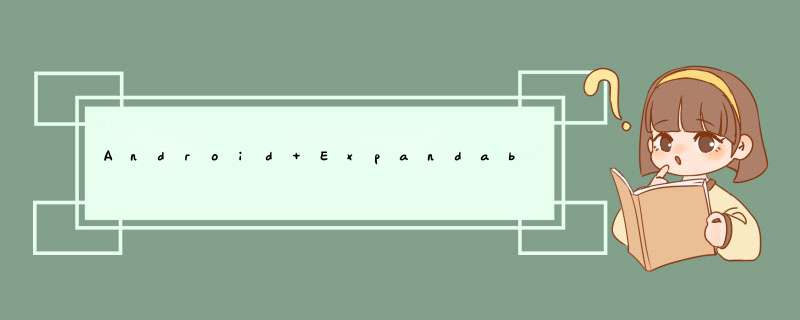
在上一篇Android ExpandableListView使用小结(一)的介绍中,我们学习了 ExpandableListVIEw 的使用方法,学习了自定义适配器,为列表选项设置监听事件。想必大家都能熟练使用了,今天我要分享的是 ExpandableListVIEw 的 Indicator(指示器)的使用。
在我们看来,Indicator 就是分组项前面的小箭头,回顾一下我们之前做的 Demo,并没有显式指定 Indicator 啊,怎么还会出现呢?原来系统自动为分组的左边加上了 Indicator,不用我们做任何 *** 作。
系统默认的Indicator
有人可能觉得系统提供的 Indicator 难看,想换成自己喜欢的,这可怎么办?当然有办法啦,开源代码总是具有良好的扩展性,这里给出几种办法:
在 Drawable 中利用 XML 定义 Indicator 的状态选择器,然后设置 ExpandableListVIEw 的 groupIndicator 属性,引用我们自定义的 Drawable。先看看我们的状态选择器部分,根据不同的状态分别定义分组展开和闭合的图标就 OK 了。
<selector xmlns:androID="http://schemas.androID.com/apk/res/androID"> <item androID:drawable="@mipmap/ic_expand" androID:state_expanded="true"/> <item androID:drawable="@mipmap/ic_collapse"/></selector>为 ExpandableListVIEw 设置 Indicator,indicatorleft 和 indicatorRight 是分别用来指定 Indicator 的左右边界的,这里我们把它放在分组项的左边。
<ExpandableListVIEw androID:ID="@+ID/expand_List" androID:layout_wIDth="match_parent" androID:layout_height="match_parent" androID:groupIndicator="@drawable/group_indicator" androID:indicatorleft="0dp" androID:indicatorRight="40dp" />看一下运行效果,除了丑陋没有其他可说的T_T...
首先,在分组项的 Item 布局里面加入 Indicator 的图标,就用一个简单的 ImageVIEw 展示吧。
<linearLayout xmlns:androID="http://schemas.androID.com/apk/res/androID" androID:layout_wIDth="match_parent" androID:layout_height="wrap_content" androID:background="@androID:color/holo_blue_light" androID:orIEntation="horizontal" androID:padding="8dp"> <TextVIEw androID:ID="@+ID/label_expand_group" androID:layout_wIDth="0dp" androID:layout_height="wrap_content" androID:layout_gravity="center_vertical" androID:layout_weight="1" androID:paddingleft="20dp" androID:textcolor="@androID:color/white" androID:textSize="20sp"/> <ImageVIEw androID:ID="@+ID/iv_indicator" androID:layout_wIDth="wrap_content" androID:layout_height="wrap_content" androID:layout_gravity="center_vertical" androID:src="@mipmap/ic_collapse"/></linearLayout>然后呢,就是在我们自定义的 Adapter 里面 *** 控了。定义一个 Map 集合存放 Indicator 的位置和图标,根据 Group 的状态动态改变 Indicator。
// 用于存放Indicator的集合private SparseArray<ImageVIEw> mIndicators;// 根据分组的展开闭合状态设置指示器public voID setIndicatorState(int groupposition, boolean isExpanded) { if (isExpanded) { mIndicators.get(groupposition).setimageReource(R.mipmap.ic_expand); } else { mIndicators.get(groupposition).setimageReource(R.mipmap.ic_collapse); }// 获取显示指定分组的视图@OverrIDepublic VIEw getGroupVIEw(int groupposition, boolean isExpanded, VIEw convertVIEw, VIEwGroup parent) { GroupVIEwHolder groupVIEwHolder; if (convertVIEw == null) { convertVIEw = LayoutInflater.from(MainActivity.this).inflate(R.layout.item_expand_group, false); groupVIEwHolder = new GroupVIEwHolder(); groupVIEwHolder.ivIndicator = (ImagVIEw)convertVIEw.findVIEwByID(R.ID.iv_indicator); groupVIEwHolder.tvTitle = (TextVIEw)convertVIEw.findVIEwByIDR.ID.label_expand_group); convertVIEw.setTag(groupVIEwHolder); } else { groupVIEwHolder = (GroupVIEwHolder) convertVIEw.getTag(); } groupVIEwHolder.tvTitle.setText(groupStrings[groupposition]); // 把位置和图标添加到Map mIndicators.put(groupposition, groupVIEwHolder.ivIndicator); // 根据分组状态设置Indicator setIndicatorState(groupposition, isExpanded); return convertVIEw;}最后,为 ExpandableListVIEw 添加 Group 点击事件,当点击分组项的时候,改变 Indicator 的状态,就能实现我们想要的功能了。
// 设置分组单击监听事件expandableListVIEw.setonGroupClickListener(new ExpandableListVIEw.OnGroupClickListener() { @OverrIDe public boolean onGroupClick(ExpandableListVIEw parent, VIEw v, int groupposition, long ID) { boolean groupExpanded = parent.isGroupExpanded(groupposition); if (groupExpanded) { parent.collapseGroup(groupposition); } else { parent.expandGroup(groupposition, true); } adapter.setIndicatorState(groupposition, groupExpanded); return true; } });我们看看效果怎么样,不用美工我也能做得好看一点了,聊表安慰 (^_^)v
总结
以上是内存溢出为你收集整理的Android ExpandableListView(二)全部内容,希望文章能够帮你解决Android ExpandableListView(二)所遇到的程序开发问题。
如果觉得内存溢出网站内容还不错,欢迎将内存溢出网站推荐给程序员好友。
欢迎分享,转载请注明来源:内存溢出

 微信扫一扫
微信扫一扫
 支付宝扫一扫
支付宝扫一扫
评论列表(0条)